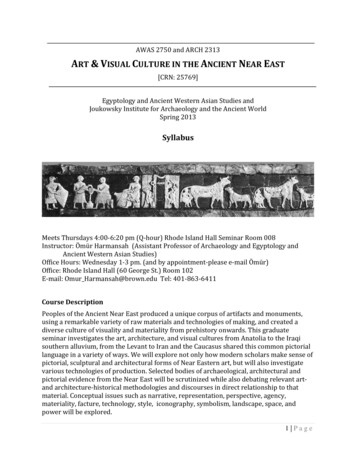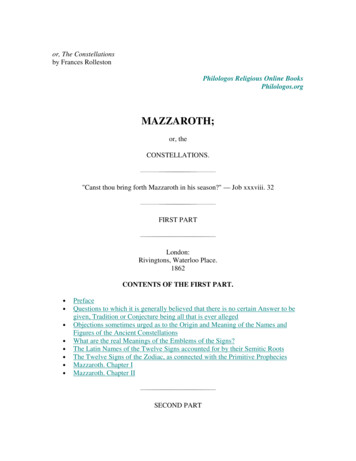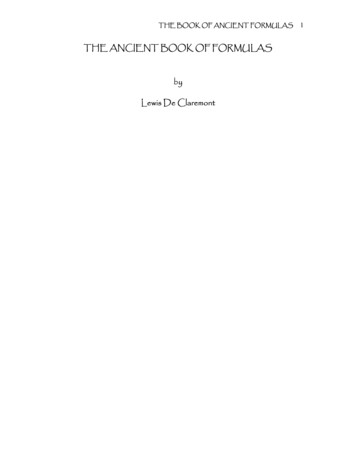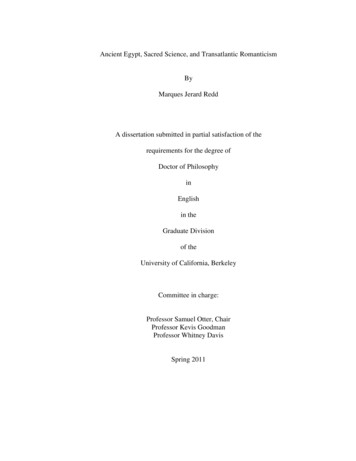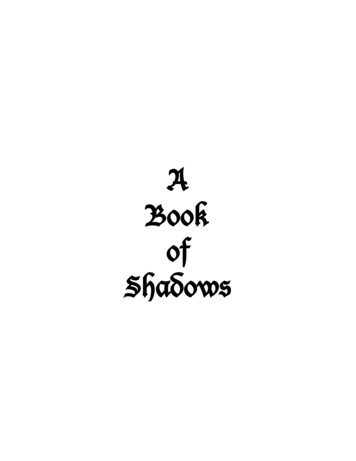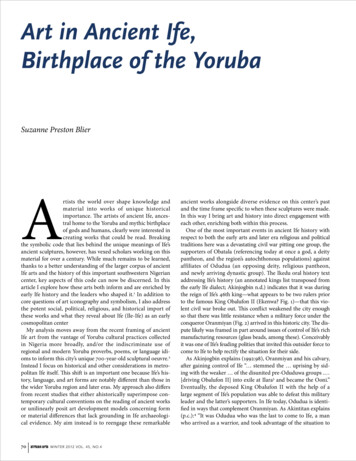
Transcription
Art in Ancient Ife,Birthplace of the YorubaSuzanne Preston BlierArtists the world over shape knowledge andmaterial into works of unique historicalimportance. The artists of ancient Ife, ancestral home to the Yoruba and mythic birthplaceof gods and humans, clearly were interested increating works that could be read. Breakingthe symbolic code that lies behind the unique meanings of Ife’sancient sculptures, however, has vexed scholars working on thismaterial for over a century. While much remains to be learned,thanks to a better understanding of the larger corpus of ancientIfe arts and the history of this important southwestern Nigeriancenter, key aspects of this code can now be discerned. In thisarticle I explore how these arts both inform and are enriched byearly Ife history and the leaders who shaped it.1 In addition tocore questions of art iconography and symbolism, I also addressthe potent social, political, religious, and historical import ofthese works and what they reveal about Ife (Ile-Ife) as an earlycosmopolitan centerMy analysis moves away from the recent framing of ancientIfe art from the vantage of Yoruba cultural practices collectedin Nigeria more broadly, and/or the indiscriminate use ofregional and modern Yoruba proverbs, poems, or language idioms to inform this city’s unique 700-year-old sculptural oeuvre.2Instead I focus on historical and other considerations in metropolitan Ife itself. This shift is an important one because Ife’s history, language, and art forms are notably different than those inthe wider Yoruba region and later eras. My approach also differsfrom recent studies that either ahistorically superimpose contemporary cultural conventions on the reading of ancient worksor unilinearly posit art development models concerning formor material differences that lack grounding in Ife archaeological evidence. My aim instead is to reengage these remarkable70 african arts Winter 2012 vol. 45, no.4ancient works alongside diverse evidence on this center’s pastand the time frame specific to when these sculptures were made.In this way I bring art and history into direct engagement witheach other, enriching both within this process.One of the most important events in ancient Ife history withrespect to both the early arts and later era religious and politicaltraditions here was a devastating civil war pitting one group, thesupporters of Obatala (referencing today at once a god, a deitypantheon, and the region’s autochthonous populations) againstaffiliates of Odudua (an opposing deity, religious pantheon,and newly arriving dynastic group). The Ikedu oral history textaddressing Ife’s history (an annotated kings list transposed fromthe early Ife dialect; Akinjogbin n.d.) indicates that it was duringthe reign of Ife’s 46th king—what appears to be two rulers priorto the famous King Obalufon II (Ekenwa? Fig. 1)—that this violent civil war broke out. This conflict weakened the city enoughso that there was little resistance when a military force under theconqueror Oranmiyan (Fig. 2) arrived in this historic city. The dispute likely was framed in part around issues of control of Ife’s richmanufacturing resources (glass beads, among these). Conceivablyit was one of Ife’s feuding polities that invited this outsider force tocome to Ife to help rectify the situation for their side.As Akinjogbin explains (1992:98), Oranmiyan and his calvary,after gaining control of Ife “ stemmed the uprising by siding with the weaker of the disunited pre-Oduduwa groups . [driving Obalufon II] into exile at Ilara3 and became the Ooni.”Eventually, the deposed King Obalufon II with the help of alarge segment of Ife’s population was able to defeat this militaryleader and the latter’s supporters. In Ife today, Odudua is identified in ways that complement Oranmiyan. As Akintitan explains(p.c.):4 “It was Odudua who was the last to come to Ife, a manwho arrived as a warrior, and took advantage of the situation to
1 MaskIle-Ife, Nigeria, c. early 14th century ceCopper. Height: 33 cmRetained in the palace since the time of its manufacture (through the early twentieth century) where itwas identified as King Obalufon Alaiyemore (Obalufon II). Nigeria National Museums, Lagos Mus. reg.no. 38.1.2.Photo: Karin Willis, courtesy of the National Commission of Monuments and Museums, Nigeria and TheMuseum for African Art, New Yorkimpose himself on Ife people.” King Obalufon II, who came torule twice at Ife, is positioned in local king lists both at the endof the first (Obatala) dynasty and at the beginning of the second (Odudua) dynasty. He is also credited with bringing peace(a negotiated truce) to the once feuding parties.Political History and Art at Ancient IfeWhat or whom do these early arts depict? Many of the ancientIfe sculptures are identified today with individuals who lived inthe era in which Ife King Obalufon II was on the throne and/or participated in the civil war associated with his reign. Thisand other evidence suggests that Obalufon II was a key sponsor or patron of these ancient arts, an idea consistent with thisking’s modern identity as patron deity of bronze casting, textiles,regalia, peace, and wellbeing. It also is possible that a majority ofthe ancient Ife arts were created in conjunction with the famoustruce that Obalufon II is said to have brokered once he returnedto power between the embattled Ife citizens as he brought peaceto this long embattled city (Adediran 1992:91; Akintitan p.c.).As part of his plan to reunite the feuding parties, Obalufon IIalso is credited with the creation of a new city plan with a large,high-walled palace at its center. Around the perimeters, thecompounds of key chiefs from the once feuding lineages werepositioned. King Obalufon II seems at the same time to havepressed for the erection of new temples in the city and the refurbishment of older ones, these serving in part to honor the leading chiefs on both sides of the dispute. Ife’s ancient art workslikely functioned as related temple furnishings.One particularly art-rich shrine complex that may have comeinto new prominence as part of Obalufon II’s truce is that honoring the ancient hunter Ore, a deity whose name also featuresin one of Obalufon’s praise names. Ore is identified both as animportant autochthonous Ife resident and as an opponent to“Odudua.” A number of remarkable granite figures in the OreGrove were the focus of ceremonies into the mid-twentieth century. One of these works called Olofefura (Fig. 4) is believed torepresent the deified Ore (Dennett 1910:21; Talbot 1926 2:339;Allison 1968:13).5 Features of the sculpture suggest a dwarf orsufferer of a congenital disorder in keeping with the identity ofmany first (Obatala) dynasty shrine figures with body anomalies or disease. Regalia details also offer clues. A three-strandchoker encircles Olofefura’s neck; three bracelet coils embellishthe wrist; three tassels hang from the left hip knot. These featureslink this work—and Ore—to the earth, autochthony, and to theOgboni association, a group promoted by Obalufon II in part topreserve the rights of autochthonous residents.The left hip knot shown on the wrapper of this work, as wellas that of the taller, more elegant Ore Grove priest or servantfigure (Fig. 5), also recalls one of Ife’s little-known origin mythswithin the Obatala priestly family (Akintitan p.c.). According tothis myth, Obatala hid the ase (vital force) necessary for Earth’ssolidity within this knot, requiring his younger brother Odudua,after his theft of materials from Obatala, to wait for the latter’shelp in completing the task. Consistent with this, Ogboni members are said to tie their cloth wrappers on the left hip in memory of Obatala’s use of this knot to safeguard the requisite ase(Owakinyin p.c.). Iron inserts in the coiffure of the taller Ore figure complement those secured in the surface of the Oranmiyanstaff (Fig. 2), indicating that this sculpture—like many ancientIfe works of stone—were made in the same era, e.g. the earlyfourteenth century (see below).An additional noteworthy feature of these figures, and others,is the importance of body proportion ratios. Among the Yorubatoday, the body is seen to comprise three principal parts: head,trunk, and legs (Ajibade n.d.:3). Many Ife sculptural examples(see Fig. 4; compare also Figs. 15–16) emphasize a larger-thanlife size scale of the head (orí) in relationship to the rest of thebody (a roughly 1:4 ratio). Yoruba scholars have seen this headprivileging ratio as reinforcing the importance of this body partas a symbol of ego and destiny (orí), personality (wú), essentialnature (ìwà), and authority (àse) (Abimbola 1975:390ff, Abiodun 1994, Abiodun et. al 1991:12ff).6 Or as Ogunremi suggests(1998:113), such features highlight: “The wealth or poverty of thenation [as] equated with the ‘head’ (orí) of the ruler of a particular locality.”Both here and in ancient Ife art more generally, however, thereis striking variability in related body proportions. Such ratiosrange from roughly 1:4 for the Ore grove deity figure (Fig. 4), thecomplete copper alloy king figure (Fig. 15), the couple from Itavol. 45, no. 4 Winter 2012 african arts 71
(this page, l–r)4 Sculpture of Ore (Olofefura; Olofefunra)Ore Grove, Ile-Ife, Nigeria, c. early 14th century ceGranite; Height: 80 cmNigeria National Museums, Ife. Mus. reg.no. IF63.1.6.Photo: courtesy Hunterian Museum and Art Gallery,University of Glasgow5 Sculpture of Ore’s servant or priestOre Grove, Ile-Ife, Nigeria, c. early 14th century ceGranite; Height: 1.03mNigeria. National Museums, Lagos. Mus. reg. no.136/61 E. Re-registered as IF 57.1.7.Photo: Suzanne Preston Blier, 2008(opposite)8 Royal couple shown with interlocked feet andarmsIta Yemoo site, Ile-Ife, Nigeria, c. early 14th century ceCopper alloy; Height: 286mmNigeria National Museums, Ife. Registration no.57.1.1.Photo: Suzanne Preston Blier 2004Yemoo (Fig. 8), and many of the terracotta sculptures, to roughly1:6 for the taller stone Ore grove figures (Fig. 5) and the copperseated figure from Tada (Fig. 11). Why these proportional differences exist in Ife art is not clear, but issues of class and/or statusappear to be key. Whereas sculptures of Ife royals and gods oftenshow 1:4 ratios, most nonroyals show proportions much closerto life. In ancient Ife art, the higher the status, the greater likelihood that body proportions will differ from nature in ways thatgreatly enhance the size of the head. This not only highlights thehead as a prominent status and authority marker, but also pointsto the primacy of social difference in visual rendering.While many Ife (and Yoruba) scholars have focused on howthe head is privileged in relationship to the body, what also isimportant, and to date overlooked, is that the belly is equallyimportant. The full, plump torsos (chest and stomachs) of Ife figures depicting rulers and deities complement modern Yorubabeliefs about health and well being on the one hand, and wealthand power on the other. Related ideas are suggested by the modern Yoruba term odù (“full”) which, when applied to an individual, means both “he has blessing in abundance” and “fortuneshines on him”(Idowu 1962:33). A full belly is vital to royals anddeities not only as a reference to qualities of wellbeing but alsoas markers of state and religious fullness. In his extended discussion of the concept of odù, the indigenous Ife religious scholarIdowu notes (1962:33) that the same term also indicates a “very72 african arts Winter 2012 vol. 45, no.4large and deep pot (container)” and by extension anything thatis of “sizable worth” and/or “superior quality.” This word featurescentrally in the name for the high god, Ol-odù-marè. Accordingto Idowu (1962:34) the latter use of the term signifies “He is Onewho is superlative,” odù here invoking his very extraordinariness. Because large ceramic vessels called odù were employed inancient Ife contexts as containers for highly valued goods such asbeads and art (including the Ita Yemoo king figure, Fig. 16), thisidiom offers an interesting modern complement and descriptorfor early Ife sculptural portrayals of gods and kings as containers holding many benefits. A complementary feature of manyancient Ife works is that of composure or inner calm (àìkominún,“tranquility of the mind” in modern Yoruba; Abraham 1958:388).This notable quality finds potential expression through the complete repose shown in their faces of early Ife art (Figs. 1, 15, 16), aquality that increases the sense of monumentality and power inthese remarkable works.The ancient Ife arts from Ife’s Ore shrine, which appear to havebeen carved as a single sculptural group, include a stone vesselwith crocodiles on its sides (Fig. 6). On its lid a frog (or toad)is shown in the jaws of a snake. The latter motif references thecontestation between Obatala and Odudua for the center’s control (Akintitan p.c.; Adelekan p.c.). According Akintitan (p.c.),this design addresses the less-than-straight manner in whichOdudua asserted control over Ife, since poisonous snakes are
thought not to consume frogs (and toads). The crocodile, likeseveral other animal figurations from this grove, honor Ore’shunting and fishing prowess. Carved crocodiles, giant eggs,a mudfish (African lung fish), and an elephant tusk referencethe watery realm that dominated primordial Ife. A granite slabfrom this same site shows evenly placed holes (Fig. 7). This workserved perhaps as a real or metaphoric measuring device forIfe’s changing water levels, in keeping both with frequent flooding here (referenced in local accounts about Obalufon II’s wifeQueen Moremi) as well as Ife origin myths in which the Earth issaid to have been formed only after Odudua sprinkled dirt uponthe water’s surface (Idowu 1962, Blier 2004).One especially striking art-rich Ife site that also seems tohave been identified with Obalufon II and his famous politicaltruce is Ita Yemoo, the term yemoo serving as the title for firstdynasty Ife queens. This temple complex lies near the site wherethe annual Edi festival terminates. The Edi ritual is dedicated toObalufon II’s wife, Moremi, who also at one time was married toObalufon II’s adversary, the conqueror Oranmiyan. One of themost striking works from Ita Yemoo is a copper alloy casting of aking and queen (Fig. 8) with interlocked arms and legs. The maleroyal wears a simian skull on his hip, a symbol of Obatala (monkeys evoking the region’s early occupants) and this deity’s identity with Ife’s autochthonous residents and first dynasty line. Thefemale points toward the ground, gesturing toward Odudua asboth second dynasty founder and later Yoruba earth god.7 Thisroyal couple appears to reference in this way not only the painfulIfe dynastic struggle between competing Ife families and chiefs,but also the political and religious marriage promoted by Obalufon II between the these groups as part of his truce. Interestingly,a steatite head recovered by Frobenius at Offa (Moremi’s hometown north of Ife) wears a similar queen’s crown. Offa is adja-cent to Esie where a group of similar steatite figures were found.8These Esie works conceivably also were identified with Moremi,the local heroine who became Ife’s queen.A second copper alloy figure of a queen from the Ita Yemoosite is a tiny sculpture showing a recumbent crowned femalecircumscribing a vessel set atop a throne. She holds a scepterin one hand; the other grasps the throne’s curving handle (Fig.9). Her seat depicts a miniature of the quartz and granite stoolsidentified in the modern era primarily with Ife’s autochthonous(Obatala-linked) priests. The scepter that she holds is similar toanother work from Ita Yemoo depicting a man with unusual (forIfe) diagonal cheek mark (Willett 2004:M26a), a pattern similar to markings worn by northern Yoruba residents from Offaamong other areas. The recumbent queen’s unusual composition appears to reference the transfer of power at Ife from thefirst dynasty rulership group to the new (second) dynasty lineof kings, here symbolized through a queen, what appears to beQueen Moremi, the wife of Obalufon II.Another striking Ita Yemoo sculpture, a Janus staff mount(Fig. 10) shares similar symbolism. The work depicts two gaggedhuman heads positioned back-to-back, one with vertical linefacial marks, the other plain-faced, suggesting the union of twodynasties (see below). This scepter likely was used as a club andevokes both the punishment that befell supporters of eitherdynastic group committing serious crimes and the unity of thetwo factions in state rituals involving human offerings, amongthese coronations. This scepter mount’s weight and heightenedarsenic content reinforces this identity. A larger Janus sceptermount from this same site depicts on one side a youthful headand on the other a very elderly man, consistent with two different dynasty portrayals, and the complementary royal unification/division themes.A large Ife copper figure of a seated male was recovered atTada (Fig. 11), an important Niger River crossing point situatedsome 200 km northeast of Ife. This sculpture is linked in important ways not only to King Obalufon II, but also to Ife trade,regional economic vitality, and the key role of this ruler in promoting Ogboni (called Imole in Ife), the association dedicatedto both autochthonous rights and trade. The work is stylistically very similar to the Obalufon mask (Fig. 1). Both are madeof pure copper and were probably cast by members of the sameworkshop. Although the forearms and hands of the seated figure are now missing, enough remains to suggest that they mayhave been positioned in front of the body in a way resemblingthe well-known Ogboni association gestural motif of left handfisted above right (Fig. 12). This same gesture is referenced in thesmaller standing figure (also cast of pure copper) from this sameTada shrine (Fig. 13). Obalufon descendant Olojudo reaffirmed(p.c.) the gestural identity of the standing Tada figure. As I haveargued elsewhere (1985) Yoruba works of copper are associatedprimarily with Ogboni and Obalufon, consistent with the latterruler’s association with bronze casting and economic wellbeing.Another notable Ogboni reference in these two copper worksfrom Tada is the diamond-patterned wrapper (Morton Williams1960:369, Aronson 1992) tied at the left hip with a knot.How the ancient Ife seated sculpture (and other works) foundtheir way to this Tada shrine has been a subject of consider-vol. 45, no. 4 Winter 2012 african arts 73
9 Bowl depicting a recumbent scepter-holdingqueen atop a looping handle throneIta Yemoo Site, Ile-Ife, Nigeria, c. early 14th century ceCopper alloy; Height: 121 mmNigeria National Museums, Lagos. no. L.92.58.Photo: courtesy Frank Willett Collection. Hunterian Museum, University of Glasgow11 Seated figureIle-Ife, Nigeria, c. early 14th century ceCopper. Height: 53.7 cmFound on a shrine in Tada, on the Niger River, 192km. northeast of Ife. Nigeria National Museums,Lagos: 79. R. 18.Photo: Karin Willis, courtesy of the National Commission of Monuments and Museums, Nigeria and TheMuseum for African Art, New York12 Possible original gesture of seated figure fromTada (Fig. 11).Drawing: Suzanne Preston Blierable scholarly debate. I concur with Thurstan Shaw in his view(1973:237) that these sculptures most likely were brought to thiscritical river-crossing point because of the site’s identity withNiger River trade. As Shaw notes (1973:237) these works seemto be linked to Yoruba commercial engagement along the NigerRiver “ marking perhaps important toll or control points ofthat trade.” Specifically, the seated Tada figure offers importantevidence of Ife’s early control of this critical Niger River crossing point. Copper alloy castings of an elephant and two ostriches(animals identified with valuable regional trade goods) whichwere found on this same Tada site likely reference the importance of ivory and exotic feathers in the era’s long distance trade.The goddess Olokun (Fig. 14) who spans both the first and second dynasty religious pantheons, is closely identified with promoting related commerce.Contesting Dynasties: Politics of the BodyTwo copper alloy castings depicting royals (Figs. 15–16)offer important insight into early Ife society, politics, and history. One is the half-figure of a male from Ife’s Wunmonije site,where a corpus of life-size copper alloy heads (Figs. 27–28) wasunearthed. The other sculpture is the notably similar full-lengthstanding figure from the Ife site of Ita Yemoo, the locale wherethe royal couple (Fig. 8), tiny enthroned queen sculpture (Fig. 9),and metal scepter (Fig. 10) were created.9 Based on style and similarities in form, the two works clearly were fashioned around thesame time, conceivably during Obalufon II’s reign. Their crownsare different from the tall, conical, veiled are crowns worn by Ifemonarchs today. The latter crown a form also seen on the tiny Ifefigure of a king found in Benin (Fig. 17).10Based on both their cap-form head coverings and the horn eachholds in the left hand, the figures have been identified as portraying rulers in battle (Odewale p.c.).11 Not only are the rulers’caps reminiscent of the smaller crowns (arinla) worn by Yorubarulers in battle, suggests Odewale (p.c.), but historically, antelope horns similar to those carried in their left hands were usedin battle. These horns were filled with powerful ase (authority/74 african arts Winter 2012 vol. 45, no.4force/command), substances that could turn the course of war inone’s favor. When so filled, the horns assured that the king’s wordswould come to pass, a key attribute of Yoruba statecraft. The twoappear to be competitors (e.g. competing lineages) vying for theIfe throne, references to the ruling heads of Ife’s first (Obatala) andsecond (Odudua) dynasties shown here in ritual battle.While these two royal sculptures are very similar in style andiconography, there are notable differences, including the treatment of the rulers’ faces—one showing vertical line marks, theother lacking facial lines. There are also notable distinctions inheaddress details, specifically the diadem shapes and cap tiers.The diadem of the Wunmojie king with striated facial marks(Fig. 15) displays a rosette pattern surmounted by a pointedplume, this motif resting atop a concentric circle. The headdressdiadem on the plain-faced (unstriated) Ita Yemoo king figureinstead consists of a simple concentric circle surmounted by apointed plume. The rosette diadem of the king with facial striations seems to carry somewhat higher rank, for his diadem is setabove the disk-form, as if to mark superior position. Moreover,the cap of the king with vertical facial markings integrates fourtiers of beads while the plain-faced king’s cap shows only three.
These differences both in crown diadem shapes and bead rowssuggest that, among other things, the king bearing the verticalline facial marks and rosette-form diadem (the Wunmonije siteruler) carries a rank that is both different from and in some wayshigher than that of the plain-faced royal.There also are striking distinctions in facial marking and regalia details of these two king figures, differences that offer additional insight into the meaning and identity of these and otherworks from this center. Similar rosette and concentric circlediadem distinctions can be seen in many ancient Ife works. TheAroye vessel (Fig. 18), which displays rosette motifs and a monstrous human head referencing ancient Ife earth spirits (erunmole, imole; Odewale p.c.), may have functioned as a divinationvessel linked to Obatala, a form today in Ife that employs awater-filled pot. The copper alloy head of first dynasty Ife goddess Olokun (Fig. 14) also incorporates a rosette with sixteenpetals. Ife chiefs and priests today sometimes wear beaded pendants (peke) that incorporate similar eight-petal flower forms orrosettes. These individuals include a range of primarily Obatala(first dynasty) affiliates: Obalale (the priest of Obatala), Obalase(the Oluorogbo priest), Obalara (the Obalufon priest), and ChiefWoye Asire (the priest of Ife springs and markets.12 Rosette-formdiadems such as these also can be seen on ancient Ife terracottaanimals identified with Obatala, among these the elephant (Fig.20) and duiker antelope heads from the Lafogido site. Theserosettes suggest the importance of plants (flowers), and the primacy of ancient land ownership and gods to the Obatala group.Concentric circle-form diadems, in contrast, seem to reference political agency as linked in part to the new Oduduadynasty (Akintitan p.c., Adelekan p.c.). In part for this reason,a concentric circle is incorporated into the iron gate at the frontof the modern Ife palace. Agbaje-Williams notes (1991:11) thatthe burial spots of important chiefs sometimes are marked withstone circles as well. Concentric circle form diadems are displayed on the terracotta sculptures of ram and hippopotamusheads from Ife’s Lafogido site. Both animals seem to be connected to the Odudua line and the associated sky deity pantheonof Sango among others (Idowu 1962:94, 142; Matory 1994:96).If, as Ekpo Eyo suggests (1977:114; see also Eyo 1974) the groupof Lafogido site animal sculptures were conceived as royalemblems, their distinctive crown diadems suggest that theseworks, like the two king figures, were intended to represent twodifferent dynasties and/or the gods associated with them. Theking figure with vertical facial markings and a rosette-form diadem instantiates the first dynasty or Obatala rulership line. Theplain-faced ruler with concentric circle diadem evokes the second or Odudua royal line.Number symbolism in diadem and other forms is importantin these and other ancient Ife art works serving to mark gradeand status. According to Ife Obatala Chief Adelekan (p.c), eightpetal rosettes are associated with higher Obatala grades. Thatthe Wunmonije king figure wears an eight-petal rosette (Fig. 15)while the Aroye vessel (Fig. 18) and Olokun head (Fig. 14) incorporate sixteen-petal forms is based on power difference. Eight isthe highest number accorded humans, suggests Chief Adelekan,whereas sixteen is used for gods.1313 Standing figurewith top braid coiffureand Ogboni association gesture, 14th–15thcentury ceCopper; Height: 56.5cmFound on the sameTada shrine as Figure11. Nigeria NationalMuseum, Enugu.Drawing: Suzanne Preston BlierFacial Marking Distinctions:Ife as a Cosmopolitan CenterOne of the most striking differences in the two royal figuresand other Ife arts can be seen in the variant facial markings.Scholars have put forward several explanations for these facialpattern disparities in Ife and early regional arts. Among the earliest were William Fagg and Frank Willett (1960:31), who identified vertical line facial marks with royal crown veils and the“shadows” cast onto the face by associated strings of beads.14 Thisis highly unlikely, however, since many ancient works depictingwomen and nonroyals without crowns display the same verticalfacial patterns. Moreover, of the two copper-alloy king figures(Figs. 15–16), only one shows vertical marks, and they both weara kind of cap (oro) that does not include a beaded veil. Modernwoodcarvings of Ife royals wearing traditional veiled crowns alsodo not show vertical line facial marks. Due to related inconsistencies, Willett would later retract his original shade-line theoryand Fagg would not again discuss this in his later scholarship. Assuggested above, the presence and lack of vertical facial markson the two Ife king figures further reinforces the identity of theserulers as leaders of the two competing dynasties.15An array of early and later artistic evidence supports this.Among these is a Lower Niger style vessel (Fig. 21) collected nearBenin that displays a human face with vertical markings beneaththe head of an elephant, an animal that in Ife is closely identified with Obatala and the first dynasty. This elephant head has itscomplement in the Lafogido site terracotta elephant head witha rosette-form diadem (Fig. 20), a site where a terracotta headvol. 45, no. 4 Winter 2012 african arts 75
with vertical facial marks also was buried (Eyo 1974). Nineteenthand early twentieth century royal masks of the Igala (a Yorubalinked group) associated with the ancient Akpoto dynasty (whoare ancestors of the current Igala rulers), display similar thinvertical line facial markings referencing the early royals of thisgroup (Sargent 1988:32; Boston 1968:172) (Fig. 22). The ancientIfe terracotta head that represents Obalufon I (Osangangan Obamakin, the father of Obalufon II) displays vertical marks (Fig.23) consistent with the king’s first-dynasty associations. Vertical line facial marks such as these appear to reference Ife royals(as well as other elites) and ideas of autochthony more generally.16 The fact that some 50 percent of the ancient Ife terracottaheads and figures show vertical line facial markings suggestshow important this group still was in the early second dynastyera when these works were commissioned. The second largestgrouping of Ife terracotta works—around 35 percent—show nofacial markings at all, in keeping with modern Ife traditions forbidding facial marking for members of Ife resident families.Ife oral tradition maintains that facial marking practices wereat one point outlawed. Accordingly, late nineteenth to earlytwentieth century art and cultural practices display a strongaversion to facial marks of any type. Most likely it was Ife KingObalufon II who helped promote this change after his return topower as part of his plan for a more lasting truce. This change,and the need sometimes to cover one’s historical family anddynastic identity for reasons of political expediency, is also suggested by two masks, one of terracotta and one of copper, bothidentified with Obaufon II. One of these (Fig. 1) is plain-facedand the o
tory, language, and art forms are notably different than those in the wider Yoruba region and later eras. My approach also differs from recent studies that either ahistorically superimpose con-temporary cultural conventions on the reading of ancient works or unilinearly posit art




